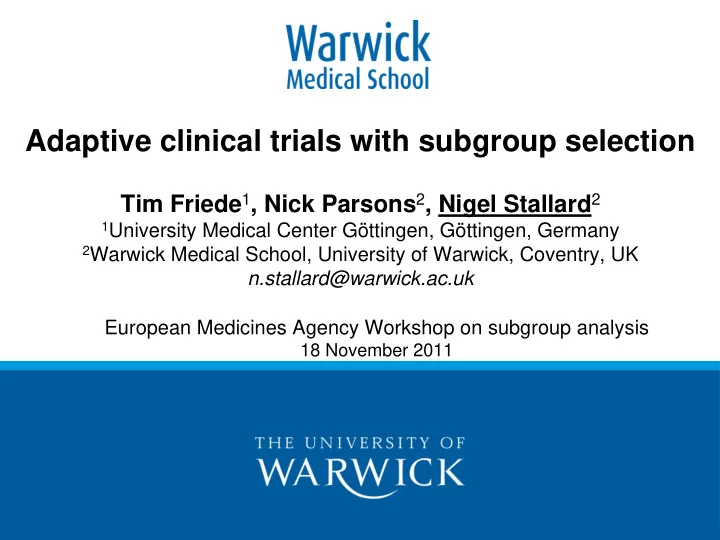

Adaptive clinical trials with subgroup selection Tim Friede 1 , Nick Parsons 2 , Nigel Stallard 2 1 University Medical Center Göttingen, Göttingen, Germany 2 Warwick Medical School, University of Warwick, Coventry, UK n.stallard@warwick.ac.uk European Medicines Agency Workshop on subgroup analysis 18 November 2011
Setting Definitive comparison of experimental treatment with control Single predefined subgroup of interest Research questions: is treatment effective in whole population is treatment effective in subgroup For confirmatory study wish to control risk of any false positive Control familywise error rate in strong sense at specified level (Wang et al 2007, Song & Chi 2007, Brannath et al 2009, Spiessens & Debois 2010, Jenkins et al 2011)
Adaptive design – idea We are testing hypotheses in full population and subgroup Controlling false positives means it is harder to show efficacy If we knew which hypothesis to test, could focus on that Adaptive design idea: use interim data to guide hypothesis to test in remainder of trial
Adaptive design – details Stage 1: Recruit from full population On basis of interim data decide to continue to (i) test full and sub-populations at final analysis (ii) test full population only final analysis (iii) test sub-population only final analysis (possibly include interim data on short-term endpoint) Stage 2: Cases (i) or (ii): continue to recruit from full population Case (iii): recruit from subgroup only Final analysis: Conduct selected tests Control error rate allowing for test selection (Song & Chi 2007, Brannath et al 2009, Jenkins et al 2011)
Test statistics Test H 0 { F } (full population) and H 0 { S } (sub population At stage i , let { F } and p i { S } be p-values for full and sub-population p i { F } and Z i { S } be test statistics for full and sub-population Z i { F } = 1 – ( Z i { S } = 1 – ( Z i { F } ), p i { S } ) p i Assume Z i { F } and Z i { S } normal with unit variance correlation where is proportion in subgroup (Spiessens and Debois 2010)
Controlliing the overall error rate Bonferroni test { F , S } = 2 min{ p i { F } , p i { S } } p i Simes test { F , S } = min{2 min{ p i { F } , p i { S } }, max{ p i { F } , p i { S } }} p i (Simes 1986) These tests ignore correlation between p { F } and p { S } Spiessens and Debois test Obtain p-value based on distribution of max{ Z i { S } , Z i { F } } (Spiessens and Debois 2010)
Combining stages 1 and 2 Combination test Obtain overall p-value for each hypothesis using pre-specified combination function (Bretz et al 2006) Conditional error function approach Obtain design assuming testing both hypotheses At interim analysis obtain error rate for second stage conditional on stage 1 data Can redesign stage 2 so long as conditional error rate is controlled e.g. restrict testing to full population or subgroup alone (Müller and Schäfer 2001, Friede et al 2011)
Simulation study Based on Brannath et al. (2009) and Jenkins et al. (2011) Model: Normal approximation for logrank test statistics Standardised effects based on haz. ratio: 0.77 in subgroup, 1 outside subgroup n 1 = 170 , n 2 = 748 (if recruit from full population) 470 (if recruit from subgroup) Subgroup prevalence: 20% to 50% Fixed designs: single study testing both hypotheses two separate studies Adaptive designs: CEF test with Spiessens and Debois test combination test with Spiessens test combination test with Simes test
Simulation study results Adaptive: CEF Adaptive: Comb test Simes Adaptive: Comb test Spiessens Fixed: separate studies Fixed: single study
Conclusions We may want to test treatment in a subgroup in addition to full population In confirmatory test need to control overall error rate Adaptive design allows us to use interim analysis data to select hypothesis(hypotheses) for final analysis Appropriate methodology exists to control overall error rate Adaptive design appears more powerful than either: fixed single stage design adjusting for multiple testing selection of hypotheses in separate study We have assumed a pre-defined subgroup. Allowing for use of interim data to select subgroup is harder!
References Brannath et al. Confirmatory adaptive designs with Bayesian decision tools for a targeted therapy in oncology. Stat Med 2009; 28: 1445–1463. Bretz et al. Confirmatory seamless phase II/III clinical trials with hypothesis selection at interim: general concepts. Biom J 2006; 48: 623–634. Jenkins, Stone, Jennison. An adaptive seamless phase II/III design for oncology trials with subpopulation selection using correlated survival endpoints. Pharm Stat 2011; 10: 347– 356. Friede, Parsons, Stallard. A conditional error function approach for subgroup selection in adaptive clinical trials. Stat Med . Submitted. Müller, Schäfer. Adaptive group sequential designs for clinical trials: Combining the advantage of adaptive and of classical group sequential approaches. Biometrics 2001; 57: 886–891. Simes. An improved Bonferroni procedure for multiple test of significance. Biometrika 1986; 73: 751–754. Song, Chi. A method for testing a prespecified subgroup in clinical trials. Stat Med 2007; 26: 3535-3549. Spiessens, Debois. Adjusted significance levels for subgroup analysis in clinical trials. Cont Clin Trials 2010; 31: 647–656. Wang, O’Neill, Hung. Approaches to evaluation of treatment effect in randomised clinical trials with genomic subset. Pharm Stat 2007; 6: 227–244.
Recommend
More recommend